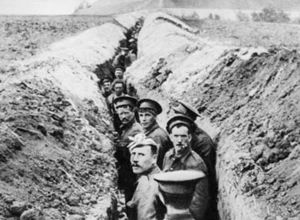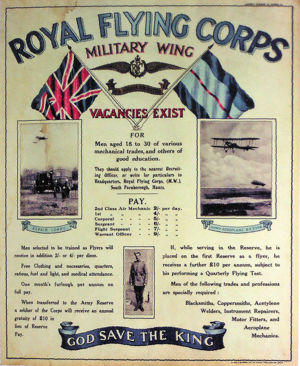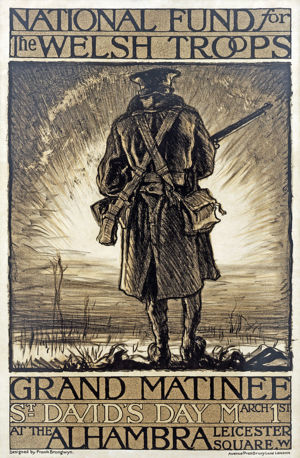- Profile
- Images
Location: [unknown]
Surnames/tags: The Great War WWI World War I
| Image:Photos-294.gif |
The British Empire entered World War I when Britain declared war on the German Empire on 4 August 1914.The United Kingdom's armed forces were reorganised, the Royal Air Force was created, in January 1916, and there was forced conscription for the first time in United Kingdom's history. There was also the raising of the largest all-volunteer army in history, known as Kitchener's Army, of more than two million men.
The British Royal family had a serious problem during the First World War because they were related to the ruling family of Germany, Britain's main opponent during the war. Before the war, the British royal family had been known as the House of Saxe-Coburg and Gotha. George V was the first cousin of the German Kaiser Wilhelm II, who came to represent all the horrors of the war. On 17 July 1917, King George issued an Order in Council that changed the name of the British Royal Family to the House of Windsor. He and his relatives who were British subjects gave up the use of all German titles and styles, and adopted English surnames.

|
| Punch cartoon depicts King George sweeping away his German titles |

|
| Herbert Henry Asquith |

|
| David Lloyd George |
Monarch - George V Civil Leaders
- Prime Ministers - Herbert Henry Asquith, (pre-1916) David Lloyd George, (post-1916)
Army
- William Robertson
- John French
- Douglas Haig

|
| William Robertson |

|
| John Fisher |
Royal Navy
- John Fisher
- Henry Jackson
- John Jellicoe
- Rosslyn Wemyss
- David Henderson
- Frederick Sykes
- Hugh Trenchard
- Godfrey Paine
British Empire Army total losses in combat from 1914 to 1918 were 876,084, which included 418,361 killed, 167,172 died of wounds, 113,173 died of disease or injury, 161,046 missing presumed dead and 16,332 died as a prisoner of war.
Army

|
| '. |
The British Army during World War I had a small volunteer force of 400,000 soldiers This included the Regular Army and reservists in the Territorial Force. Together they formed the British Expeditionary Force for service in France . The large number of volunteers in 1914–1915, known as Kitchener's Army, was destined to go into action at the battle of the Somme. In January 1916, conscription was introduced, and by the end of 1918, the army had reached a strength of four million men.

|
| The Welton, Yorkshire, England Contingent WWI |

|
| In the trenches. |

|
| British soldiers. |
Navy
The Royal Navy at the start of the war was the largest navy in the world. Their strength was at least equal to the combined strength of the next two largest navies in the world, which were France and Russia.The major part of the Royal Navy's strength was deployed at home in the Grand Fleet, with the aim of drawing the German High Seas Fleet into an engagement. The Royal Navy and the German Imperial Navy did come into contact, in the battle of Heligoland Bight, and the battle of Jutland.In 1914, the navy had also formed the 63rd (Royal Naval) Division from reservists, and this served extensively in the Mediterranean and on the Western Front. Almost half of the Royal Navy casualties during the War were sustained by this division, fighting on land and not at sea.
Air Service
At the beginning of the war, the Royal Flying Corps was sent to France and was first used for aerial spotting in September 1914. Aerial photography was attempted during 1914. General Jan Smuts recommended a new air service be formed that would be on a level with the army and navy. The formation of the new service would make the men and machines of the Royal Naval Air Service (RNAS) available for action across the Western Front. On 1 April 1918, the RFC and the RNAS were amalgamated to form a new service, the Royal Air Force (RAF).
1917, German Foreign Secretary Arthur Zimmermann sent a coded telegram to Count Johann von Bernstorff, German ambassador to Mexico if Mexico became an ally. Britain intercepted the telegram, decoded it and forwarded it to the United States.

|
| Zimmerman coded Telegram. |

|
| ' |
Sources
- Wikipedia - History of the United Kingdom during World War I
- BBC.co.uk - Britain and World War One, 1901 - 1918
- United Kingdom and World War I
- Timeline of World war I for United Kingdom
- Submarine Blockade
- GermanU boats
- Naval and Air raids
- why did Britain go to War?
- British declaration of War
- Historical sources into World War I
- Background on deprivation
- Login to edit this profile and add images.
- Private Messages: Contact the Profile Managers privately: Jacqueline Clark and Great War Project WikiTree. (Best when privacy is an issue.)
- Public Comments: Login to post. (Best for messages specifically directed to those editing this profile. Limit 20 per day.)











